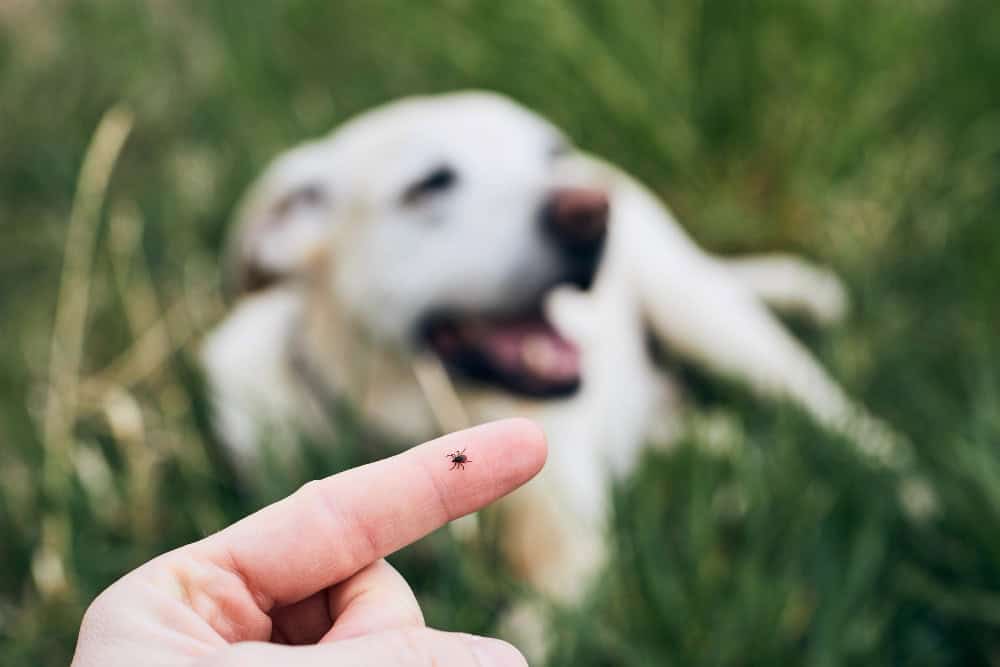
As pet parents, we all want our furry little ones to live long, happy, and healthy lives. But there’s a sneaky little threat we can’t ignore, ticks. These tiny, bloodsucking parasites don’t just cause discomfort; they can transmit some serious diseases that affect both pets and people.
Ticks love to hang out in wooded areas, tall grass, and near bodies of water, so if your dog or cat enjoys outdoor adventures, especially in warmer months, they’re at a higher risk of picking up these unwanted hitchhikers.
Let’s dive deeper into the risks, the signs to watch for, and the simple steps you can take to protect your pet.
Why Ticks Are a Big Deal?

Ticks aren’t just annoying, they’re dangerous because they carry and transmit diseases like:
- Ehrlichiosis
- Anaplasmosis
- Babesiosis
- Rocky Mountain spotted fever
When a tick bites your pet, it can pass along bacteria or parasites directly into their bloodstream. These diseases can range from mild to very serious, sometimes even life-threatening if not caught early. Ticks are most active during warm weather, so spring, summer, and early fall are the riskiest times.
If your pet loves romping in the yard, exploring trails, or hanging out near lakes and rivers, you’ll want to be extra vigilant.
Watch for These Warning Signs
The tricky thing about tick-borne diseases is that the symptoms aren’t always obvious. Your pet may not seem “sick” at first, and many signs develop gradually.
Keep an eye out for these common red flags:

- Feeling tired or weak, even after normal activities
- Loss of interest in food or noticeable weight loss
- Fever, or feeling unusually warm
- Limping, stiffness, or signs of joint pain
- Swollen lymph nodes, especially around the neck or under the chin
- Redness, rashes, or other skin irritation, particularly where a tick might have bitten
If you notice any of these, especially after your pet has been outdoors, don’t wait. A quick trip to the vet could make all the difference.
Don’t Hesitate, See the Vet
Tick-borne diseases can be serious, but the good news is that early treatment works. If you suspect your pet has been bitten or shows any of the warning signs, take them to the vet as soon as possible.
Your vet will likely run blood tests to check for infections and prescribe antibiotics or other medications, depending on what’s found. Acting quickly gives your pet the best chance at a full recovery and prevents further complications.
Keep Your Pet Safe from Ticks – Shop Trusted Pet Care Products Today
Simple Steps to Keep Ticks Away
Luckily, protecting your pet doesn’t have to be complicated. A few small steps can make a huge difference:
1. Use Tick Prevention Products
There are plenty of great products out there:
- Topical treatments that you apply directly to your pet’s skin
- Tick-repelling collars
- Oral medications you can give as a chewable pill
- Ask your vet which option works best for your pet’s size, breed, and lifestyle.
2. Keep Your Yard Tidy
Ticks love long grass and brush piles, so keeping your yard neat makes it less inviting for them:
- Mow the lawn regularly
- Remove tall weeds, fallen leaves, and any brush piles
- A clean yard is not just prettier but safer.
3. Check Your Pet After Outdoor Time
After walks, hikes, or playtime in the backyard, take a few minutes to check your pet:
- Look carefully around the ears, neck, underarms, and between the toes
- If you find a tick, remove it gently with tweezers or a tick removal tool, making sure you get the whole thing out.
4. Avoid High-Risk Areas
When possible, stick to well-trodden paths and avoid tall grasses or overgrown areas. If you can’t avoid them, stay on the trail and consider protective sprays or preventive measures.
In Conclusion
Ticks might be small, but they can cause big problems. They attach to pets and feed on their blood, spreading dangerous diseases that can sneak up without warning.
The good news? With a little care and attention, you can keep your furry friend safe. Regular use of tick prevention products, a tidy yard, careful inspections, and smart choices about where to explore are all easy steps that help prevent tick-borne diseases.
At the end of the day, our pets rely on us to keep them safe. Stay alert, stay proactive, and your best friend will stay happy, healthy, and full of life.
FAQs
What are tick-borne diseases?
Tick-borne diseases are illnesses transmitted to pets (and humans) through the bite of an infected tick. These diseases include Lyme disease, Rocky Mountain spotted fever, ehrlichiosis, and more.
How do ticks infect my pet?
When a tick attaches to your pet’s skin and feeds on their blood, it can pass harmful bacteria or parasites directly into their bloodstream, leading to disease.
How can I prevent my pet from getting ticks?
-Use vet-recommended tick prevention products (topical treatments, collars, or oral medications).
-Keep your yard tidy by mowing grass and removing debris.
-Check your pet thoroughly after outdoor activities.
-Avoid walking in tall grass or dense wooded areas when possible.
Can I remove a tick myself?
Yes, you can remove a tick using fine-point tweezers or a tick removal tool. Gently grasp the tick as close to the skin as possible and pull it straight out without twisting. Always clean the area afterward and monitor your pet for symptoms.
When should I see a veterinarian?
If your pet shows any signs of illness after a tick bite or if you’re unable to remove a tick properly, visit your vet immediately. Early detection and treatment greatly improve outcomes.
Are tick-borne diseases dangerous for humans, too?
Yes, many tick-borne diseases, like Lyme disease, can infect both humans and pets. That’s why preventing ticks on your pets also helps protect your whole family.
(The article is written by Mantasha, Executive, Clinical Health & Content, and reviewed by Monalisa Deka, Senior Health Content Editor)